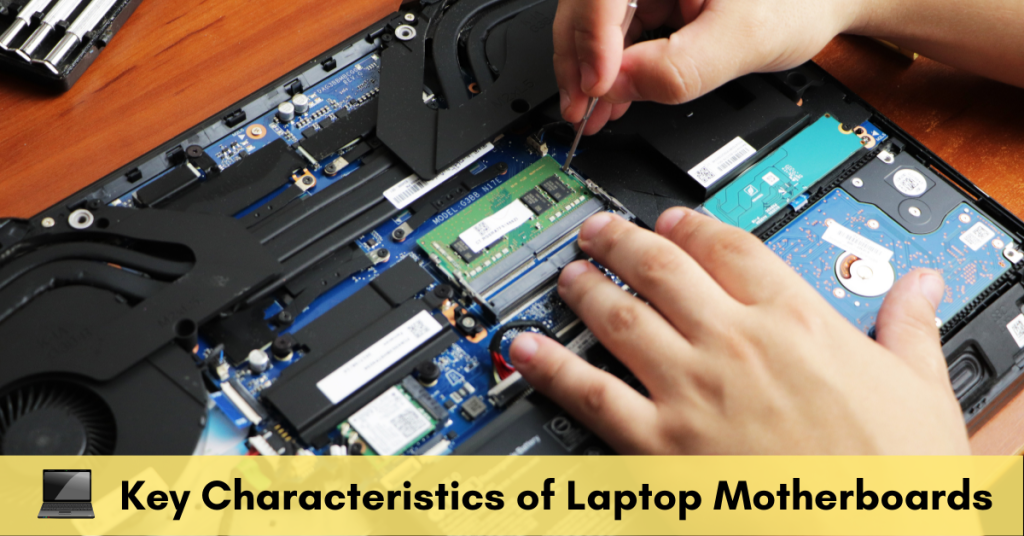Discover the essential characteristics of laptop motherboards and learn how these components affect your laptop’s performance and compatibility, and make informed decisions when selecting or upgrading your laptop.
For troubleshooting issues, expanding capabilities, and ensuring overall stability and performance, it is imperative to understand the key characteristics of laptop motherboards.

Laptop motherboards are the backbone of any laptop computer. They are the central hub that connects all the components of a laptop and facilitates their communication. In this article, we will explore the major characteristics of laptop motherboards.
What is a Characteristic of Laptop Motherboards: 6 Essential Factor
1. Form Factor
The form factor of a motherboard refers to its size and shape. It determines the overall layout of a laptop and affects its design and performance. Laptop motherboards come in various form factors, but the most common ones are Mini-ITX and Micro-ATX.
Mini-ITX motherboards are the smallest form factor and are commonly used in ultraportable laptops. They are compact, lightweight, and energy-efficient, making them ideal for portable devices. However, they have limited expansion options due to their small size.
Micro-ATX motherboards are larger than Mini-ITX and offer more expansion options. They are commonly used in mid-range laptops and have a good balance of performance and affordability.
2. Chipset
The chipset is a set of electronic components that manages the communication between the CPU, memory, and other components of a laptop. It is an essential component of a motherboard that affects its performance and compatibility.
The two most popular chipset brands used in laptops are Intel and AMD. Intel chipsets are commonly used in laptops powered by Intel CPUs, while AMD chipsets are used in laptops powered by AMD CPUs.
Chipsets affect laptop performance by controlling the speed and bandwidth of the system bus and memory. They also affect compatibility by determining the type of CPU and memory that can be used with a motherboard.
3. Socket Type
The socket type of a motherboard refers to the physical interface between the CPU and the motherboard. It is an essential component that determines the compatibility and performance of a laptop.
The two most common socket types used in laptops are LGA and PGA. LGA stands for Land Grid Array, and PGA stands for Pin Grid Array. LGA sockets have pins on the motherboard, while PGA sockets have pins on the CPU.
Socket type affects laptop CPU compatibility and performance by determining the type and number of pins required to connect the CPU to the motherboard. It also affects the speed and bandwidth of the system bus and memory.
4. Expansion Slots
Expansion slots are ports on a motherboard that allow users to add or upgrade components to a laptop. They are an essential component that affects the upgrade options and performance of a laptop.
The two most common expansion slots used in laptops are PCIe and M.2. PCIe stands for Peripheral Component Interconnect Express, and M.2 stands for Next Generation Form Factor (NGFF).
PCIe slots are used for high-speed devices such as graphics cards and network cards. They offer a higher bandwidth and lower latency than other expansion slots.
M.2 slots are used for solid-state drives (SSDs) and Wi-Fi cards. They offer a compact size and high speed, making them ideal for ultraportable laptops.
5. RAM Slots
RAM slots are ports on a motherboard that allow users to add or upgrade memory to a laptop. They are an essential component that affects the memory capacity and performance of a laptop.
The two most common RAM slot types used in laptops are SO-DIMM and DIMM. SO-DIMM stands for Small Outline Dual In-Line Memory Module, and DIMM stands for Dual In-Line Memory Module.
SO-DIMM slots are used for laptops due to their small size, while DIMM slots are used for desktop computers due to their larger size. RAM slots affect laptop memory capacity and performance by determining the maximum amount of memory that can be installed and the speed of the memory.
6. Power Delivery
Power delivery is the process of providing power to a laptop through the motherboard. It is an essential component that affects the charging speed and compatibility of a laptop.
The two most common power delivery methods used in laptops are DC-in and USB-C. DC-in is a traditional method that uses a power adapter to charge a laptop. USB-C is a newer method that allows users to charge their laptops using a USB-C port.
Power delivery affects laptop charging speed and compatibility by determining the maximum power that can be delivered to a laptop and the type of connector used to deliver the power.
What is the difference between laptop motherboard and desktop motherboard?
Having an understanding of the differences between laptop motherboards and desktop motherboards can be helpful. The following figures and facts may differ depending on the specific model and manufacturer of the laptop or desktop motherboard. In addition, some modern laptop motherboards may be able to expand.
| Laptop Motherboard | Desktop Motherboard |
|---|---|
| Generally smaller in size, averaging around 12 inches by 9 inches | Generally larger in size, averaging around 9.6 inches by 9.6 inches |
| Integrated graphics card | May or may not have integrated graphics card |
| Limited expansion capabilities | More expansion capabilities |
| Usually have only one RAM slot | May have multiple RAM slots |
| Usually have only one storage drive slot | May have multiple storage drive slots |
| Power consumption is lower | Power consumption is higher |
| Often more expensive to repair or replace | Often less expensive to repair or replace |
| Generally less powerful than desktop motherboards | Generally more powerful than laptop motherboards |
Final Words
In conclusion, understanding the key characteristics of laptop motherboards is crucial when selecting or upgrading a laptop. The form factor, chipset, socket type, expansion slots, RAM slots, and power delivery are all essential components that affect the performance and compatibility of a laptop.
By knowing the characteristics of laptop motherboards, users can make informed decisions when selecting or upgrading a laptop. They can choose a motherboard that meets their needs and budget while ensuring optimal performance and compatibility.
Frequently Asked Questions
Can I replace a Toshiba motherboard with an HP motherboard?
No, Toshiba motherboards and HP motherboards are typically not interchangeable due to differences in size, layout, and compatibility with other components.
Why are laptop motherboards burned?
Laptop motherboards can become burned or damaged due to a variety of reasons, such as power surges, overheating, or physical damage. This can result in various issues such as the laptop not turning on, random shut downs, or display issues.
What is The Cost of a Laptop Motherboard?
The cost of a laptop motherboard can vary widely depending on the make and model of the laptop, as well as the complexity of the motherboard itself. On average, a replacement laptop motherboard can cost anywhere from $50 to $500, with more high-end gaming laptops and ultrabooks generally having more expensive motherboards.
As for an example of a laptop with a strong motherboard, the Lenovo ThinkPad X1 Carbon is often regarded as having a high-quality and durable motherboard. It is designed for business use and built to withstand the wear and tear of daily use.
Are Lenovo laptop motherboards bad?
While some Lenovo laptops may experience motherboard issues or failures, it is not necessarily a widespread problem across all Lenovo laptop models. It is important to properly maintain and care for your laptop to minimize the risk of motherboard issues.
Why do some laptops have smaller motherboards?
Laptops have smaller motherboards to fit into the compact form factor of a laptop. This helps to keep the laptop lightweight, portable, and energy-efficient.
Is it worth repairing a laptop motherboard?
It depends on the extent of the damage and the cost of repair. In some cases, it may be more cost-effective to replace the entire laptop rather than repair the motherboard. However, if the issue is minor and the repair cost is reasonable, repairing the motherboard can extend the life of your laptop.


